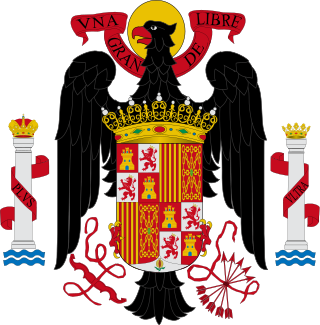Top Qs
Timeline
Chat
Perspective
Movimiento Nacional
Nationalist-inspired mechanism during Francoist rule in Spain From Wikipedia, the free encyclopedia
Remove ads
The Movimiento Nacional (English: National Movement) was a governing institution of Spain established by General Francisco Franco during the Spanish Civil War in 1937. During Francoist rule in Spain, it purported to be the only channel of participation in Spanish public life.[1][failed verification] It followed a doctrine of corporatism in which only so-called "natural entities" could express themselves. It was abolished in 1977.
This article needs additional citations for verification. (August 2025) |
You can help expand this article with text translated from the corresponding article in Spanish. (September 2025) Click [show] for important translation instructions.
|
Flags of the National Movement
Rojigualda (Spanish national flag)
Flag of the Falangist Movement
Flag of the Traditionalist Movement
Remove ads
Composition
The Movimiento Nacional was primarily composed of:
- The sole legal party, called Falange Española Tradicionalista y de las Juntas de Ofensiva Nacional Sindicalista (FET y de las JONS) which had been created at the beginning of the Spanish Civil War. Other parties were prohibited (the sole name of "party" was prohibited to design any type of organization). Government officials, military officers and trade unionists of the state trade union automatically became nominal members of the party, although their membership was often purely nominal.[2][3]
- The sole trade union organization, called Organización Sindical Española (OSE, popularly known as the Sindicato Vertical), defined as the junior organization of FET y de las JONS,[4] composed of corporatist organizations which gathered employers and workers, in opposition to Marxism's class warfare.
- All civil servants and holders of public office, were requested to swear an oath to the Principles of the National Movement.
Remove ads
Leadership
The National Movement was led by Francisco Franco, titled Jefe del Movimiento (English: Chief of the Movement), assisted by a "Minister-Secretary General of the Movement". The hierarchy extended itself to all of the country, with a "local chief of the movement" named in each village.
Ideology
Summarize
Perspective
People who strongly identified with the Movimiento Nacional were colloquially known as Falangistas or Azules ("Blues"), from the colour of the shirts worn by the Falange Militia, José Antonio Primo de Rivera's fascist organization created during the Second Spanish Republic. Camisas viejas (Old shirts) enjoyed the honour of being historical members of the Falange, compared to Camisas nuevas (New shirts), who could be accused of opportunism.
The ideology of the Movimiento Nacional was summed up by the slogan ¡Una, Grande y Libre!, which stood for the indivisibility of the Spanish state and the refusal of any regionalism or decentralization, its imperial character, both past (the defunct Spanish Empire in the Americas) and foreseen (in Africa), and its independence towards the purported "Judeo-Masonic-Marxist international conspiracy" (a personal obsession of Franco), materialized by the Soviet Union, the European democracies, the United States (until the Pact of Madrid of 1953), or the "exterior enemy" which could threaten the nation at any time; as well as towards the long list of "internal enemies", like "anti-Spanish", "reds", "separatists", "liberals", "Jews" and "Freemasons", among others, coining expressions like "judeomarxistas".
Francoist "families"
Summarize
Perspective
Since one-party rule was enforced in Francoist Spain, the only practical expression of pluralism consisted in the mixture of internal "families" (Familias del Regimen) competing together inside the National Movement. These roughly included four "families" with a genealogy tracing back to the right-wing political groups in the interwar period: the Falangists (or azules, originally from the Fascist FE de las JONS), with a preeminence over FET y de las JONS, the Spanish Syndical Organization (OSE), and the "social" government areas; the Carlists (issued from Traditionalist Communion), who held a tight control over the Ministry of Justice; the monarchist Alfonsines (issued from Renovación Española and Acción Española), well connected to the economic elites and the military command; and the National Catholics, "Catholics" in the sense of closely linked to politically Catholicist entities serving the Church's interests (issued from CEDA), embodied by the National Catholic Association of Propagandists (ACNP).[5] In addition, a new family emerged in the 1950s, the technocrats, conservatives linked to the Opus Dei who embraced a businesslike approach to the administration of the state.[5]
Franco held his power by balancing these internal rivalries, cautious not to show any favoritism to any of them nor compromise himself too much to anyone.
Fractions of those families eventually migrated to dissident stances. These included examples such as the intermittent dissent of a part of the Alfonsist monarchists who vouched for an immediate coronation of Juan de Borbón as king, as well as a sizeable part of the Catholicist family joining by late Francoism the opposition to the dictatorship subsumed within Christian democratic groups.[6]
Remove ads
Minister-Secretaries General of the Movement
Remove ads
Electoral history
See also
- José Larrañaga Arenas
- Mottos of Francoist Spain
- Grand Council of Fascism, governing body of Fascist Italy
References
Wikiwand - on
Seamless Wikipedia browsing. On steroids.
Remove ads











